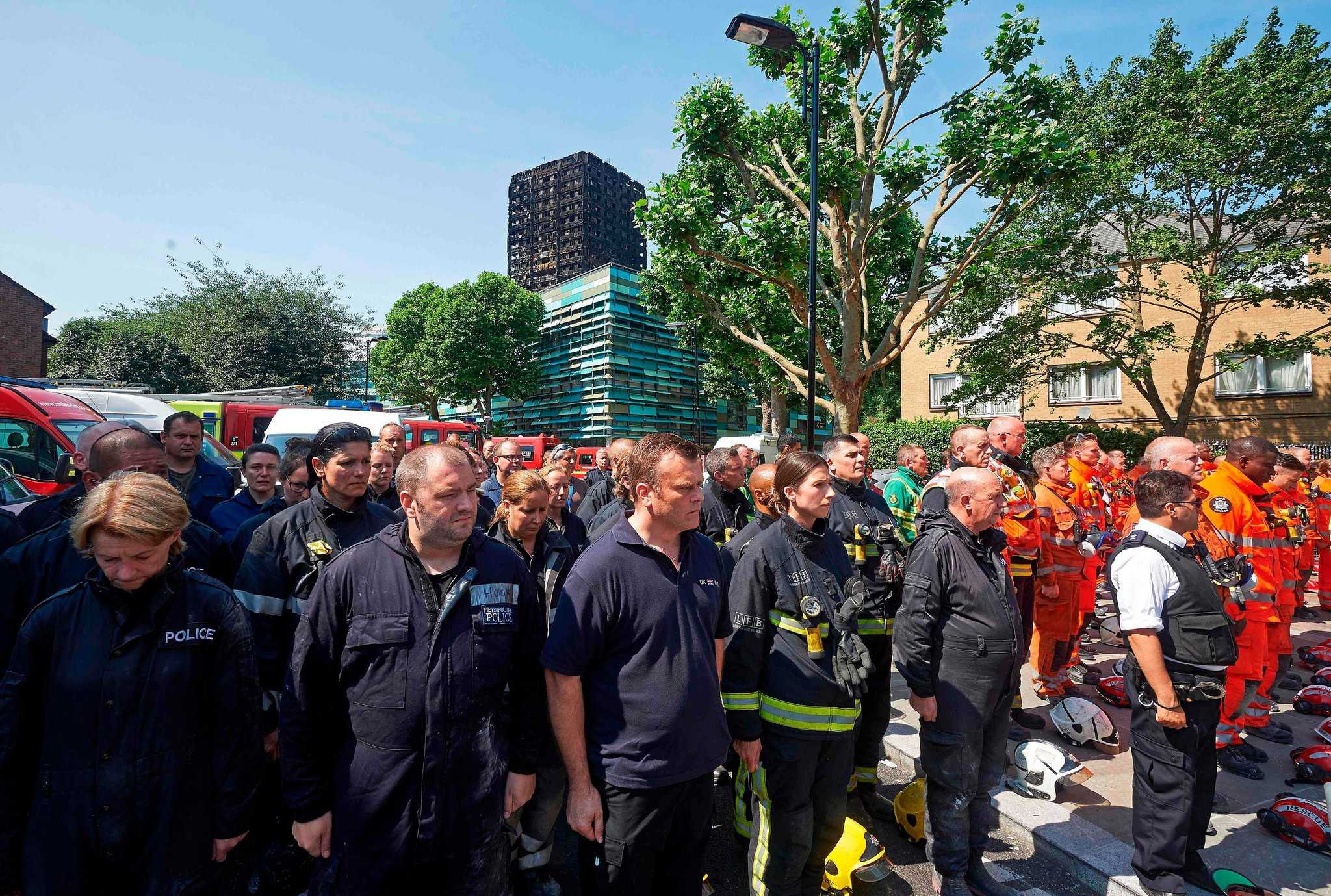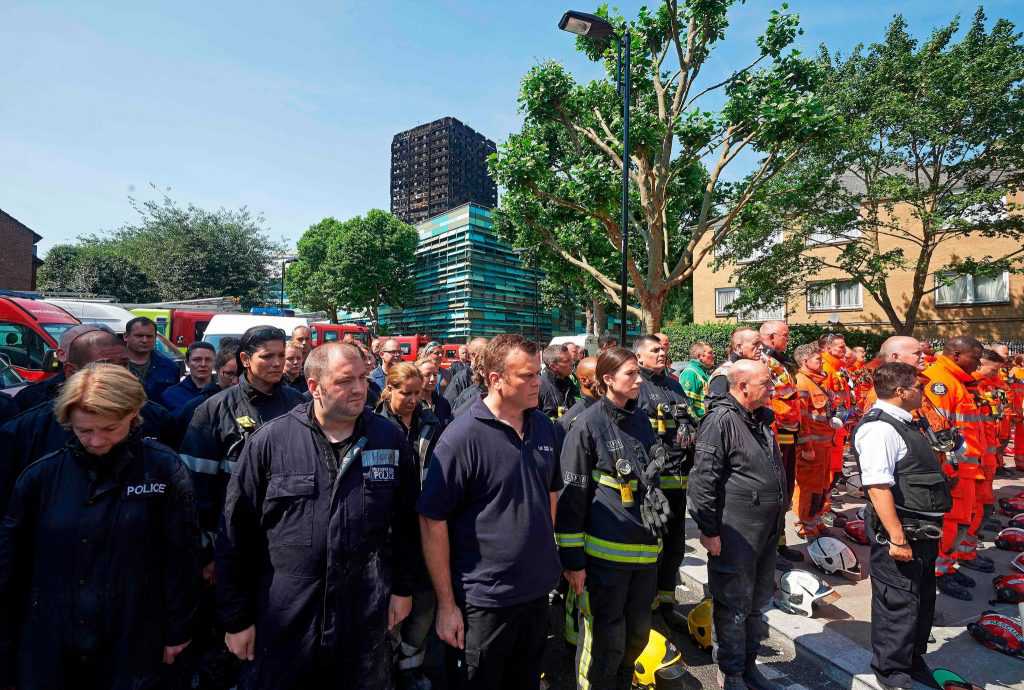
LONDON — In the aftermath of Britain’s deadliest fire in decades, two senior officials sought to deflect blame from the government over the weekend by arguing that the type of building material believed to have spread flames rapidly up the 24-story Grenfell Tower had been banned under national fire safety regulations.
But experts on British fire safety rules say that the material, used as exterior cladding, in fact complied with regulations. Other countries, including the United States, have placed stricter restrictions on how such materials can be used, but Britain had not yet done so, they said.
The question of whether the cladding complied with national regulations — and whether those regulations were too lax — is a central part of the investigation into the horrific blaze last week. It will help determine how much blame falls on the government, and how much is assigned to the tower’s owners or builders.
The toll rose on Monday to 79 confirmed or presumed dead and was expected to climb further, making the fire the country’s deadliest in decades, perhaps since the early 20th century. It broke out at the West London tower early on Wednesday, lasted six hours and incinerated the building. Hundreds were left homeless. The government has announced a formal public inquiry, and a criminal investigation has been opened.
LONDON — In the aftermath of Britain’s deadliest fire in decades, two senior officials sought to deflect blame from the government over the weekend by arguing that the type of building material believed to have spread flames rapidly up the 24-story Grenfell Tower had been banned under national fire safety regulations.
But experts on British fire safety rules say that the material, used as exterior cladding, in fact complied with regulations. Other countries, including the United States, have placed stricter restrictions on how such materials can be used, but Britain had not yet done so, they said.
The question of whether the cladding complied with national regulations — and whether those regulations were too lax — is a central part of the investigation into the horrific blaze last week. It will help determine how much blame falls on the government, and how much is assigned to the tower’s owners or builders.
The toll rose on Monday to 79 confirmed or presumed dead and was expected to climb further, making the fire the country’s deadliest in decades, perhaps since the early 20th century. It broke out at the West London tower early on Wednesday, lasted six hours and incinerated the building. Hundreds were left homeless. The government has announced a formal public inquiry, and a criminal investigation has been opened.
The material in the exterior cladding consisted of insulation sandwiched between two sheets of aluminum. The type used at Grenfell Tower is made under the Reynobond name by Arconic, a company spun off from the aluminum giant Alcoa last year. It was installed around the tower, which was built in 1974, in a renovation completed last year.

Critics of the material have warned for years that aluminum surface sheets can melt in a fire, after which flames could race through flammable insulation. If other protections fail and fire penetrates the cladding, “It is like you have got a high-rise building and you are encasing it in kerosene,” said Edwin Galea, director of the Fire Safety Engineering Group at the University of Greenwich. “It is insanity, pure and simple.”
Such a runaway blaze appears to have been precisely what happened at Grenfell Tower. The flames engulfed the building in a matter of minutes, moving from the outside inward and emitting a dark smoke characteristic of burning insulation.
Recriminations over the failure to prevent the disaster and the sluggish response have contributed to a political crisis for Prime Minister Theresa May, whose Conservative Party lost its majority in a parliamentary election six days before the fire.
If Britain had already banned the material that appears to have spread the fire — as the ministers asserted on Sunday — that would move responsibility for the disaster away from the government and point instead to possible crimes by the tower’s owners and their contractors.
The use of the material is a sensitive issue for the British government because the United States and other countries years ago banned its application in tall buildings on the grounds that it was a fire hazard. In recent years, a series of highly publicized blazes in the United Arab Emirates and Australia has called attention to the problem and spurred more countries to adopt similar restrictions.
Philip Hammond, the chancellor of the Exchequer, said in a television interview on Sunday that he believed that Britain had done the same.

“My understanding is the cladding in question, this flammable cladding which is banned in Europe and the U.S., is also banned here,” Mr. Hammond said in an interview with Andrew Marr of the BBC. “So there are two separate questions. One: Are our regulations correct, do they permit the right kind of materials and ban the wrong kind of materials? The second question is: Were they correctly complied with?”
He added: “That will be a subject that the inquiry will look at. It will also be a subject that the criminal investigation will be looking at.”
Greg Hands, the minister for trade and investment, said in a separate interview with Sky News on Sunday that “my understanding is that the cladding that was reported was not in accordance with building regulations.”
But several British experts on fire safety said that the existing rules had not, in fact, banned use of the cladding, even in high-rise buildings like Grenfell Tower. The critical building regulation — Clause 13 of Appendix A of Document B — requires only that the exterior “surface of a composite product” used as exterior cladding must be “composed throughout of materials of limited combustibility.”
The sheets of aluminum believed to have been the “surface” around flammable insulation at Grenfell Tower would pass this test, even though the surfaces could, and did, melt in a fire.
“This is where it all falls down,” Arnold E. Tarling, a chartered surveyor and expert on fire prevention who is a member of the Association for Specialist Fire Protection, said in an interview. “The surface melts and it burns like a furnace.” But the cladding nonetheless “complied with the regulations,” he said.

The United States and other countries allow only low buildings to use such cladding because of the fire hazard. British regulations may seek to limit the spread of the flames by requiring builders to divide potentially flammable cladding with fireproof barriers at horizontal or vertical intervals. But engineers and experts say that such barriers have proven ineffective in other fires around the world. The flames can often circumvent them.
Along with the cladding, investigators are looking, among much else, at the absence of sprinklers and a centralized alarm system in the building, which is not uncommon for British apartment blocks as old as Grenfell Tower, and guidance that urged residents to “stay put” and await instructions if a fire broke out in someone else’s unit.
Many residents of the tower block are still unaccounted for, and the police have said that because of the intensity of the fire, some remains may never be identified.
Newsletter Sign Up
Thank you for subscribing.
An error has occurred. Please try again later.
You are already subscribed to this email.
View all New York Times newsletters.
- See Sample
- Manage Email Preferences
- Not you?
- Privacy Policy
- Opt out or contact us anytime
“As of this morning, I’m afraid to say there are now 79 people who we believe are either dead or missing, and I sadly have to presume they are dead,” Cmdr. Stuart Cundy said in remarks to journalists on Monday. Of those fatalities, he said the police had formally identified five victims.
Mrs. May’s office said that the terms of reference for the inquiry were being drafted, and that she wanted answers quickly. The prime minister’s office has also contacted all local authorities in England asking them to identify any safety concerns in light of the tragedy, it said. It added that Mrs. May did not support a proposal by the leader of the opposition Labour Party, Jeremy Corbyn, to seize unoccupied properties to rehouse survivors of the fire.
Mrs. May has now pledged 5 million pounds, or about $6.4 million, to help the victims of the fire. And on Sunday, the British government took direct control of the emergency response, sidelining local officials whose actions had been criticized as slow and disorganized.

Even so, residents complained on Monday about a lack of coordination among officials, emergency services and various aid groups.
“Nobody is giving us the information we need about our missing family members or about how long we will spend sleeping in hotels,” said Ibrahim Arian, whose uncle Saber Neda is among those feared dead in the fire.
The building’s residents were largely people of modest means, many from troubled countries like Sudan, Eritrea and Syria. The contrast between the deprivation of the building and the wealth of Kensington and Chelsea, one of London’s richest boroughs and home to the tower, has been a subject of intense debate.
Abdur Rahman, chief executive of Al Manaar, a Muslim community center that is providing refuge and support to survivors and their families, said that coordination had improved in recent days and that help desks had been set up in the center for displaced residents to claim emergency relief funds, find lawyers and meet with psychologists.
But survivors said the delay in finding out for certain about their loved ones was foremost in their minds.
“As the days are going past, hope is fading, but it’s not completely lost,” said Leila Amani, who survived the fire and has been given temporary shelter at a hotel in the Earl’s Court neighborhood. “The first thing the people need to know is whether their family members are dead or alive. Nothing else matters at this point.”
We’re interested in your feedback on this page. Tell us what you think.




























